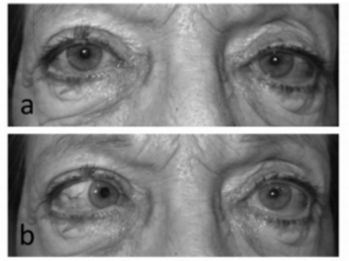 1
1
Question:
Describe the appropriate steps to take in the emergency department when evaluating anisocoria.
 1
1
Question:
Describe the appropriate steps to take in the emergency department when evaluating anisocoria.
 4
4
a. Photograph of the patient showing right partial ptosis. The left lid shows compensatory lid retraction because of equal innervation of the levator palpabrae superioris (Herring’s law).
b. Post tensilon test: Note the improvement in ptosis.
Question: Describe the appropriate steps to take in the emergency department when evaluating ptosis of recent onset.
Questions:
![]()

a. Primary position b. Left gaze 1
Question: Where is the lesion likely to be located?
1. Brain stem
2. Spinal cord
3. Left cavernous sinus
4. Left superior orbital fissure
5. Left orbit